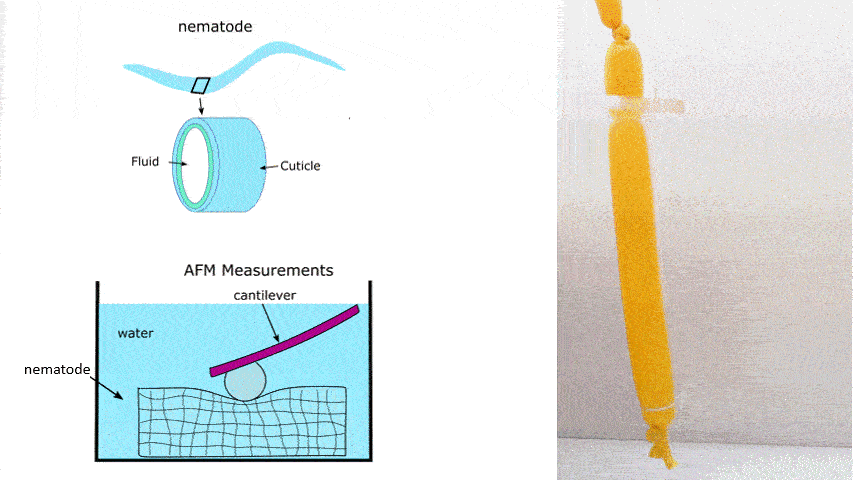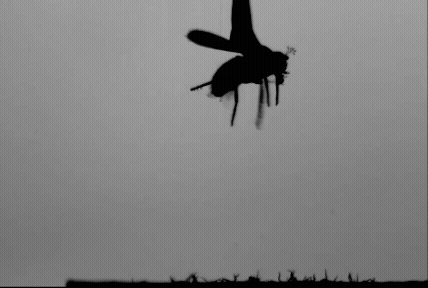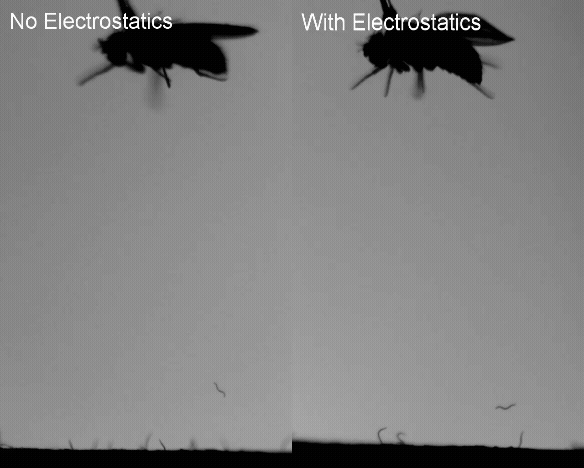Leaping Legless Worms
how cAN Worms and robots jump when they don’t have any legs to stand on?
Nematode jumping under a high-speed camera. Video credit: Victor Ortega-Jimenez
these tiny, parasitic roundworms jump 10X faster than the blink of an eye, all without legs.
Steinernema carpocapsae are tiny nematodes that parasitize insects. They are 0.5 millimeters long but only 20 micrometers wide, thinner than a human hair! In the field, these nematodes parasitize insects by leaping off the ground and landing on their hosts. While scientists have known since the 1950s that these nematodes can jump, the mechanism by which they propel themselves off the ground is still not understood. Additionally, they only jump as a juvenile in the dauer stage. How are nematodes able to jump and seek an insect host when it has finite energy in this stage?
We investigate nematode jumping mechanics with high-speed videography and answer how this tiny creature can jump in a fraction of a second. The nematode jumps by bending its cylindrical body and storing elastic energy in its cuticle. They bend so much that their body forms a kink! Through physical models, we show that this kink is critical to the nematode’s jump. In collaboration with colleagues from UC Berkeley and Riverside, our lab highlights how a reversible kink instability enables ultrafast nematode jumps, contributing to bio-inspired soft robotics design for advanced, controlled locomotion.
Soft robotic model with visible “kink”.
This project has been featured in aaas and more
Major questions
How can a limbless worm jump?
What role does the kink play in the worm’s jump?
Can the principles of reversible kink instability in nematodes be applied to the design of soft robots?
What we’ve discovered
Nematodes Jump by Using Their Body as a Spring
We found that these nematodes bend their bodies like springs to store energy for their jumps. Here is how they do it: they stand up vertically, then bend their bodies, forming a loop. They hold this loop with a liquid latch and tighten its body to its limit, signaled by a kink forming on its body. The stored force from the body wanting to unbend overcomes the latch, and the energy is released in a jump. Our experiments also show that our jumping nematode, S. carpocapsae, has a stiffer cuticle compared to a similar-sized nematode C. elegans, which does not jump. This increased stiffness contributes to spring energy storage in jumping nematodes.
Nematodes Control Their Jump Direction
By controlling its launch orientation, the nematode can jump bidirectionally. Using high-speed videography, we found that the worm changes its head and body orientation to direct its jumps.
We Model Jump Direction Based On Initial Postures
We recreated bidirectional jumping in our Silicone elastomer-based robot (Soft Jumping Model, named SoftJM). This shows how small changes in posture can result in careful tuning of jump direction. Using numerical modeling, we simulated a phase-space of jumping postures, exploring a multitude of initial jump postures and relating a range of initial postures to the take-off direction.
Reversible Kink Allows Force-Limited Systems to Store More Elastic Energy
Like a balloon filled with water, the nematode is a hydroskeleton with a tough cuticle. Using scaled up experiments on water balloons, we demonstrate that on a bent object, a kink deformation causes the forces to rise at a slower rate as bending increases. For nematodes, a kink in the worm's body allows it to stay within its limits of maximum muscle forces and keep bending and storing more energy until its latch debonds.
Bio-Inspired Soft Robotics Design
The use of simple flexible rods as adaptive limbs open possibilities for soft robotics using more sophisticated geometrical and topological instabilities, laying the foundation for building new adaptive jumping structures. By mimicking the nematode's ability to form, kink, and release a tight loop, soft robots can achieve controlled and powerful jumps, even on complex granular substrates like sand.
Static Electricity Helps Worms Stick the Landing
Insects naturally build up electric charge as they fly. When a nematode jumps close, that charge can pull the worm through the air, helping it land on the host (a fruit fly) even if its aim isn’t perfect.
Worms Charge Themselves Before Takeoff
While standing on moist ground, the nematode’s body becomes negatively charged, almost like prepping a tiny magnet. Once airborne, that charge makes the worm attracted to positively charged insects.
Wind Becomes a Worm’s Flight Assist
A gentle wind can lift and drift nematodes higher, putting them into faster airflow, the same currents that help pollen and plant seeds travel long distances. If there’s also a charged insect flying nearby, the worm can ride the wind until electrostatics take over and pull it in for a landing. The result? Even a parasite smaller than a grain of sand can reach hosts far away, no wings required.
Read the paper
Reversible kink instability drives ultrafast jumping in nematodes and soft robots. Science Robotics (2025)
Electrostatics facilitate midair host attachment in parasitic jumping nematodes. PNAS (2025)












